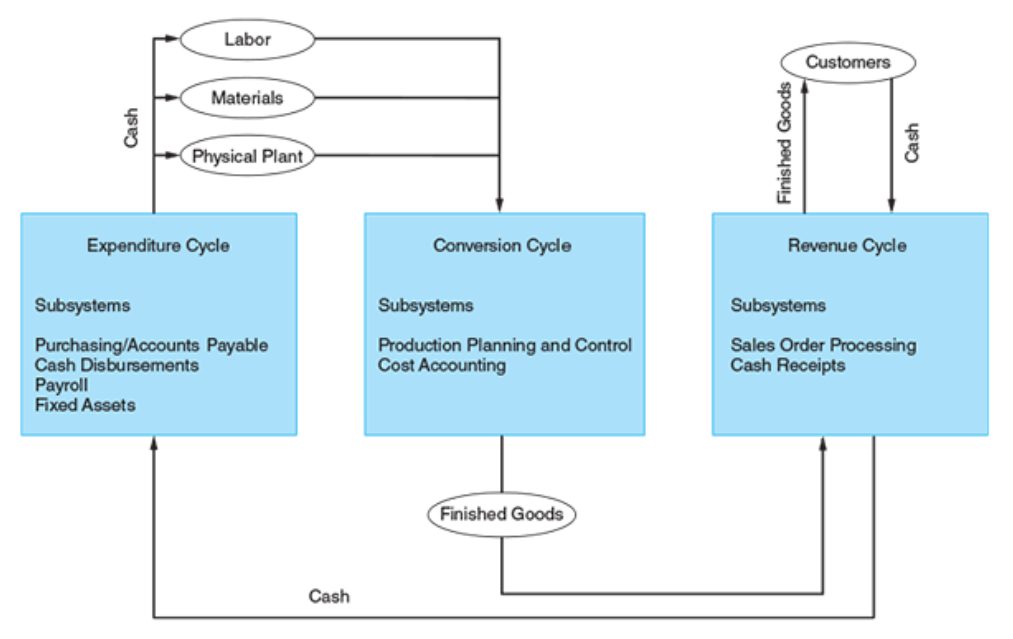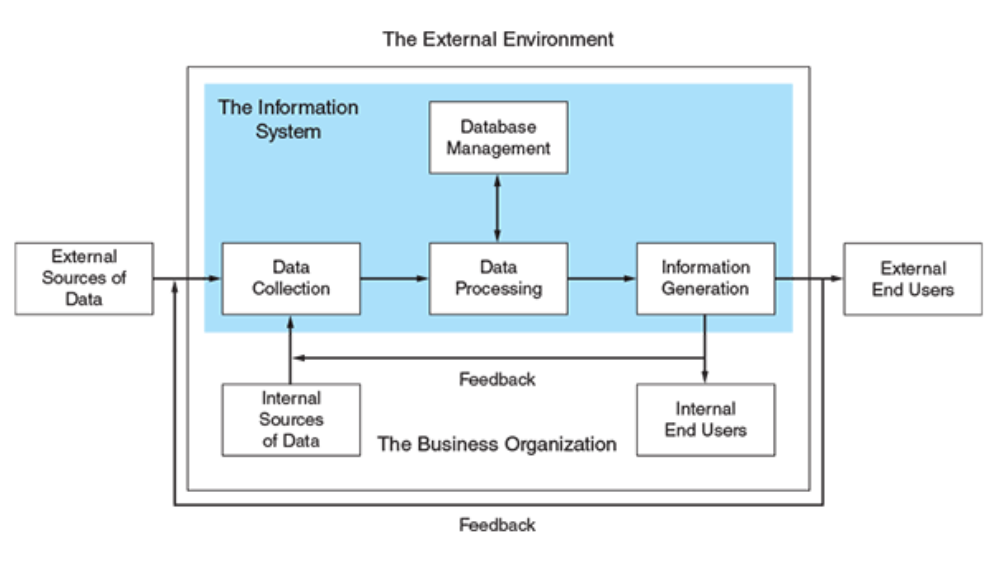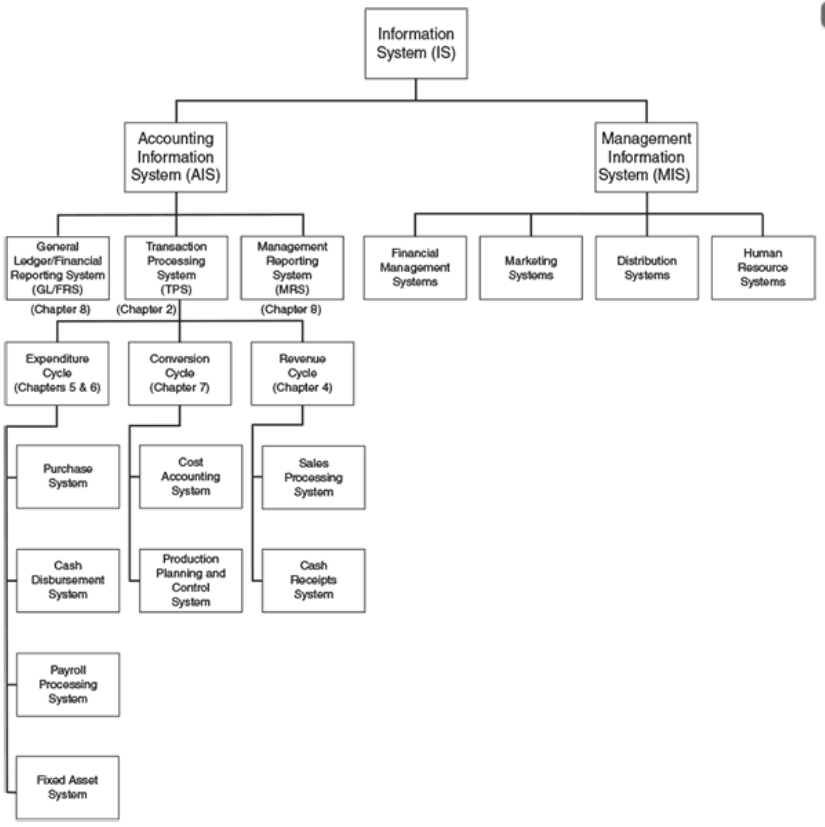D217 - Accounting Information Systems
1/276
Earn XP
Description and Tags
wgu d217
Name | Mastery | Learn | Test | Matching | Spaced |
|---|
No study sessions yet.
277 Terms
Transaction
An event that affects or is of interest to the organization and is processed by its information system as a unit of work. There are financial and nonfinancial transactions.
Financial transaction
An economic event that affects he assets and equities of the organization, is reflected in its accounts and is measured in monetary terms.
Ex.: sales of products to customers, purchases of inventory, and cash disbursement and receipts
AIS Three Major Subsystems
Transaction Proessing System (TPS)
General Ledger/Financial Reporting System (GL/FRS)
Management Reporting System (MRS)
Transaction Process System (TPS)
Central to overall function of the IS
Converts economic events into financial transactions
Records financial transactions in the accounting records
Distributes essential financial information to operations personnel
Has 3 transaction cycles
TPS 3 Transaction Cycles
The Revenue Cycle
The Expenditure Cycle
The Conversion Cycle

General Ledger / Financial Reporting Systems (GL/FRS)
Bulk of the input to the GL portion comes from transaction cycle subsystems
FRS measures the status of financial resources and the changes in those resources
Nondiscretionary reporting: organization has few or no choices in the information it provides. Much of this information consists of traditional financial statements, tax returns, and other legal documetns
Management Reporting System (MRS)
Provides the internal financial information needed to manage a business
Can include budgets, variance reports, cost-volume-profit analyses, and reports using current cost data
Processes nonfinancial transactions that are not normally processed by traditional AIS
Discretionary reporting: organization chooses what information to report and how to present it.
General Model for AIS
Means it applies to ALL AIS

Key Elements of AIS Applicaiton
End Users
Data Sources
Data Collection (First Stage)
Data Processing
Database Management
Information Generation
Feedback
1 - End Users
External: creditors, stockholders, investors, regulatory agencies, tax authorities, suppliers, and customers
Internal: management and operational
Data vs Information
2 - Data Sources
Financial transactions that enter the IS from either internal or external sources
External Financial Transaction (Most common): Sale of goods, services, the purchase of inventory, receipt of cash, disbursement of cash
Internal Financial Transaction: exchange of resources within the organization
Movement of raw materials into work-in-process (WIP), the application of labor and overhead to WIP, the transfer of WIP into finished goods inventory, and the depreciation of plant and equipment
3 - Data Collection (First Stage)
Relevant data
Efficient data
4 - Data Processing
Group that manages the computer resources used to perform day to day processing of transactions
Simple
Complex
5 - Database Management
Physical repository for financial and nonfinancial data
Organized in a logical hierarchy
Arranged as attribute, record, file
Fundamental tasks: storage, retrieval, deletion
Guidelines:
Data Attribute
Record = Collection of Attributes
File = Collection of Record
Database Management Tasks
Database Management - Data Attribute
A logical and relevant characteristic of any entity about which the firm captures data.
Database Management - Record
A complete set of attributes for a single occurrence within an entity class
Unique identifier
Database Management - File
A complete set of records of an identical class
Database Management Tasks
Storage
assigns keys to new records and stores them in their proper location in the database.
Retrieval
the task of locating and extracting an existing record from the database for processing
Deletion
the task of permanently removing obsolete or redundant records from the database
6 - Information Generation
Relevance
The contents of a report or document must serve a purpose.
Timeliness
Information must be no older than the time frame of the action it supports
Accuracy
Information must be free from material errors.
Completeness
No piece of information essential to a decision or task should be missing.
Summarization
Information should be aggregated in accordance with the user’s needs
7 - Feedback
Internal
Example: feedback will initiate the inventory ordering process to replenish
External
Example: feedback about the level of uncollected customer accounts can be used to tailor credit granting policies
The Information Environment
Information is a business resource
External users: customers, suppliers, stakeholders, or anyone who has an interest in the firm
External Users fall into two groups:
Trading partners
Stakeholders
Three Information Objectives
To support the firm’s day-to-day operations
To support management decision making
To support the stewardship function of management
An Information Systems Framework
Information System is the set of formal procedures by which data are collected, stored, processed into information, and distributed to users.

Two Broad Classes of Systems emerge from decomposition:
Accounting information Systems (AIS)
Management information system (MIS)
Segments
A functional Unit of a business organization.
Examples of Segmentations:
Materials Management
Production (*conversion cycle)
Marketing
Distribution
Personnel
Finance
Materials Management Segmentation
Subfunctions
Purchasing
Receiving
Storage
Production Segmentation (Conversion Cycle)
Two broad classes
Primary manufacturing activities
Shape and assemble raw materials into finished goods
Production support activities
Production planning
Quality control
Maintenance
Four Information Technology Functions:
Data Processing
Centralized
Distributed
Systems Development and Maintenance
Data Administration
Network Administration
Centralized Data Processing
Model under which all data processing is performed by one or more large computers, housed at a central site, that serve users throughout the organization.
Distributed Data Processing
Reorganizing the IT function into small information processing units (IPUs) that are distributed to end users and placed under their control.
Systems Development
Commercial Software
Turnkey Software
Custom Software
Enterprise Resource Planning (ERP)
Systems assembled of prefabricated software components
Systems development life cycle
Software development process
Custom syustems are more expensive
Outsourcing the IT Function
Cloud Computing
Software as a Service (SaaS)
Infrastructure as a Service (IaaS)
Platform as a Service (PaaS)
Accountants as System Auditors
External (Attestation) Audits
Internal (Operational) Audits
External (Attestation) Audits
Also known as financial audits
An independent attestation performed by an expert who expresses an opinion in the form of a formal audit report regarding the presentation of financial statements.
Attest function
Substantive tests
Attest Function
Independent auditor’s responsibility to opine as to the fair presentation of a client firm’s financial statement.
Substantive Tests
Tests that determine whether database contents fairly reflect the organization’s transactions.
The Expenditure Cycle
Incurs expenditures in exchange for resources
The Conversion Cycle
Provides value added through its products and services
The Revenue Cycle
Receives revenue from outside sources
Digital Accounting Records
Modern accounting systems store data in four types of digital computer files:
Master files
Transaction files
Reference files
Archive files
Master Files
Include account data, examples include subsidiary ledgers, general ledger
Transaction Files
Temporary file of transaction records, examples include sales orders, inventory receipts, and cash receipts
Reference Files
Stores data used as standards for processing transactions, examples include payroll program, price list, authorized suppliers, employee rosters, credit history files, freight charges
Archive Files
Contains records of past transactions that are retained for future reference, examples include journals, prior-period payroll info, former employee info, written off accounts
The Digital Audit Trail + Steps
Allows transaction tracing
Steps
Capture the economic event
Convert the source documents to digital form
Update the various master file subsidiary and GL control accounts effected, errors are detected
File can now be erased for the next batch
System Flowcharts
System flowchart is the graphical representation of the physical relationships among key elements of a system.
Revenue Cycle
It is two phases:
The physical phase involving the transfer of assets or services from the seller to the buyer
The financial phase, involving the receipt of cash by the seller in payment of the accounts receivable
Two major subsystems:
The sales order processing subsystem
The cash receipts subsystem
Data Coding Schemes
Creating simple numeric or alphabetic codes to represent complex economic phenomena that facilitate efficient data processing.
A System Without Codes
This uncoded entry takes a great deal of recording space, is time-consuming to record, and is obviously prone to many types of errors.
A System WITH Codes
Advantages of data coding in AIS are:
Concisely representing large amounts of complex information that would otherwise be unmanageable.
Providing a means of accountability over the completeness of the transactions processed.
Identifying unique transactions and accounts within a file.
Supporting the audit function by providing an effective audit trail.
Sequential Codes
Represent items in some sequential order (ascending or descending)
Advantages: Sequential coding supports the reconciliation of a batch of transactions, such as sales orders, at the end of processing.
Disadvantages: Sequential codes carry no information content beyond their order in the sequence. Also, sequential coding schemes are difficult to change.
Block Codes
Coding scheme that assigns ranges of values to specific attributes such as account classifications.
Chart of Accounts:
Advantages: Block coding allows for the insertion of new codes within a block without having to reorganize the entire coding structure.
Disadvantages: the information content of the block code is not readily apparent
Chart of Accounts:
Listing of an organization’s accounts showing the account number and name. (Critical to a firm’s financial and management reporting systems.)
Group Codes
Used to represent complex items or events involving two or more pieces of related data.
Advantages:
They facilitate the representation of large amount of diverse data.
They Allow complex data structures to be represented in a hierarchical form that is logical and more easily remembered by humans.
They permit detailed analysis and reporting both within an item class and across different classes of items.
Disadvantages: They tend to be overused.
Alphabetic Codes
Characters assigned sequentially.
Advantages: Capacity is increased by alphanumeric codes.
Disadvantages:
There is difficulty rationalizing the meaning of codes that have been sequentially assigned.
Users tend to have difficulty sorting records that are coded alphabetically.
Mnemonic Codes
Characters in the form of acronyms that convey meaning.
Advantages: does not require the user to memorize meaning
Disadvantages: they have limited ability to represent items within a class.
Revenue Cycle Activities
Data Flow Diagrams (DFDs)
Sales Order Procedures
Sales Return Procedures
Cash Receipts Procedures
Sales Order Procedures
Tasks involved in receiving and processing a customer order
Receive Order (customer order, sales order)
Check Credit (establish creditworthiness, returned approved sales order)
Pick Goods (stock release [aka picking ticket], verified stock release, possible back-order record, adjust stock records)
Ship Goods (packing slip, shipping notice, bill of lading, shipping log)
Bill Customer (sales order, S.O. pending file, sales invoice, sales journal, journal voucher, journal voucher file)
Update Inventory Records (inventory subsidiary ledger)
Update Accounts Receivable Records (AR subsidiary ledger, ledger copy)
Post to General Ledger
Sales Return Procedures
This involves reversing the previous transaction in the sales order procedure.
Prepare Return Slip
Prepare Credit Memo
Approve Credit Memo
Update Sales Journal (recorded as contra entry)
Update Inventory and AR records
Update General Ledger
Cash Receipts Procedures
They involve receiving and securing the cash, depositing the cash in the bank, matching the payment with the customer and adjusting the correct account, and properly accounting for and reconciling the financial details of the transaction.
Open Mail and Prepare Remittance List (remittance advices, remittance list)
Record and Deposit Checks (cash receipts journal, deposit slip)
Update Accounts Receivable Records
Update General Ledger
Reconcile Cash Receipts and Deposits (controller’s office, 1. A copy of the prelist, 2. Deposit slips received from the bank, 3. Related journal vouchers)
Physical Systems
Physical Accounting information systems are a combination of computer technology and human activity.
Revenue Cycle Risks
Selling to un-creditworthy customers
Shipping customers the wrong items or incorrect quantities
Inaccurately recording sales and cash receipts transactions in journals and accounts
Misappropriation of cash receipts and inventory
Unauthorized access to accounting records and confidential reports
Internal Controls for Revenue Cycle - Selling to un-creditworthy customers
Physical Control: Transaction Authorization, Segregation of Duties
IT Controls: Automated Credit Checking
Internal Controls for Revenue Cycle - Shipping customers the wrong items or incorrect quantities
Physical Control: Independent Verification
IT Controls: Scanner Technology, Automated Inventory Ordering
Internal Controls for Revenue Cycle - Inaccurately recording sales and cash receipts transactions in journals and accounts
Physical Controls: Access Controls, Segregation of duties
IT Controls: Passwords, Multilevel security
Internal Controls for Revenue Cycle - Misappropriation of cash receipts and inventory
Physical Controls: Transaction authorization, supervision, access controls segregation of duties
IT Controls: Multilevel security
Internal Controls for Revenue Cycle - Unauthorized access to accounting records and confidential reports
Physical Controls: Access Controls, Segregation of duties
IT Controls: Passwords, Multilevel security
Internal Control Activities
Physical Controls
IT Controls
Point-of-Sale (POS) Systems
Universal Product Code (UPC)
Reengineering using Electronic Data Interchange (EDI)
Devised to expedite routine transactions between manufacturers and wholesalers, and wholesalers and retailers.
Compensating Controls
Controls like supervision when you don’t have enough employees to adequately separate functions.
Two subsystems to the Expenditure Cycle
Purchases
Cash Disbursements
Purchase processing procedures
Monitor Inventory Records
Purchase Requisition
Purchase Order
Conversion Cycle
Transferring raw materials into the production process
Revenue Cycle
Selling finished goods to customer
Prepare Purchase Order
Receive Goods
Blind Copy
Receiving report
AP Pending File
Receiving Report File
Update Inventory Records
Standard Cost System
Actual Cost Inventory Ledger
Set up Accounts Payable
Supplier’s invoice
AP Packet
Open AP File
AP Subsidiary Ledger
Purchase Requisition
Document that authorizes a purchase transaction.
Purchase Order
Document based on a purchase requisition that specifies items ordered from a vendor or supplier.
Vouchers Payable System
AP dept uses cash disbursement vouchers, maintains voucher register
Post to the general Ledger
The Cash Disbursements System
Identify Liabilities Due
Prepare Cash Disbursement (check register, cash disbursements journal, update AP record, post to GL)
Greatest risk of misappropriation of funds
The greatest risk of misappropriation of funds occurs in accounts payable. This may take the form of payments for goods not ordered or received and to vendors that do not exist. The risk can be reduced through supervision, segregation of duties, independent verification, or automated processes.
Internal Control Objective
An objective of internal control is to mitigate the risk from errors and fraud.
Expenditure Cycle Transactions Risks
Unauthorized inventory purchases
Receiving wrong items, incorrect quantities, or damaged goods
Inaccurately recording purchases and cash disbursement transactions in journals and accounts
Misappropriation of cash and inventory
Unauthorized access to accounting records and confidential reports
Internal Controls for Expenditure Cycle - Unauthorized inventory purchases
Physical Controls: Transaction authorization
IT Controls: Automated purchase approval
Internal Controls for Expenditure Cycle -Receiving wrong items, incorrect quantities, or damaged goods
Physical Controls: Independent verification, supervision
IT Controls: Scanner Technology
Internal Controls for Expenditure Cycle - Inaccurately recording purchases and cash disbursement transactions in journals and accounts
Physical Controls: Transaction Authorization, accounting records, independent verification
IT Controls: Input data edits, error messages, automated postings to subsidiary and GL accounts, file backup
Following Input Data Edits Programs
Controls
Check digit
Internal Controls for Expenditure Cycle -Misappropriation of cash and inventory
Physical Controls: Supervision, Independent Verification, segregation of duties
Three-Way Match
The Purchase Order (PO)
The Receiving report
The Supplier’s Invoice
IT Controls: Automated three way match, and payment approval, multilevel security
Internal Controls for Expenditure Cycle - Unauthorized access to accounting records and confidential reports
Physical Controls: access controls, segregation of duties
IT Controls: password control, multilevel security
Payroll System General Tasks
Personnel Department (Prepare Payroll Function)
Production Department
Update WIP Account
Prepare Payroll
Distribute Paycheck
Prepare Accounts Payable
Prepare Cash Disbursement
Payroll - Personnel Department (Prepare Payroll Function)
Personnel Action Forms
Identify employees authorized to receive a paycheck
Reflect changes in pay rates, deductions, classifications
Payroll - Production Department
Job Tickets
Time the individual employee spent on each production job
Timecards
Capture the time the employee is at work.
Payroll - Update WIP Account
Forwarded to the GL function
Labor distribution Summary
Summarization of labor costs in WIP accounts
Payroll - Prepare Payroll
Prepares the payroll register showing gross pay, deductions, overtime pay, and net pay.
Enters this information into the employee payroll records
Prepares employee paychecks
Sends the paychecks to the distribute paycheck function
Files the timecards, personnel action form, and copy of the payroll register
Payroll - Distribute Paycheck
Paymaster: the individual who distributes paychecks to employees
Payroll - Prepare Accounts Payable
AP clerk reviews the payroll register for correctness
Payroll - Prepare Cash Disbursement
Payroll Imprest Account
A single account from which all paychecks for the employees are drawn.
Payroll Register
Includes: Pay rate, withholding information, and hours worked
Update General Ledger
Receives:
LABOR DISTRIBUTION SUMMARY from cost accounting,
DISBURSEMENT VOUCHER from accounts payable
JOURNAL VOUCHER from cash disbursements
Basic Technology Payroll System
Personnel action and time and attendance information from the personnel and production departments initiate the payroll process.
Payroll department reconciles this information, calculates the payroll, and sends the paychecks to the paymaster for distribution to employees.
Cost accounting receives information regarding the time spent on each job from production. This is used for posting to accounts in the WIP subsidiary ledger.
AP receives payroll summary information (payroll register) from the payroll department and authorizes the cash disbursements department to deposit a single check, in the amount of the total payroll, in a bank imprest account on which the payroll is drawn.
The general ledger department reconciles summary information from cost accounting and AP. GL accounts are updated to reflect these transactions.
Technological steps for Payroll System
Human Resources: enters data in real time
Cost Accounting
Employee Timekeeping
Data Processing
Payroll - Cost Accounting
Labor usage file: file in which the cost accounting department enters job cost data (real time or daily)
Payroll - Employee Timekeeping
Time and attendance file: generated by employees directly entering timekeeping data in real time
Biometric time clocks: verify employees’ identities by using fingerprint or hand-vein scan technology
Magnetic swipe ID cards
Proximity cards
Mobile remote devices